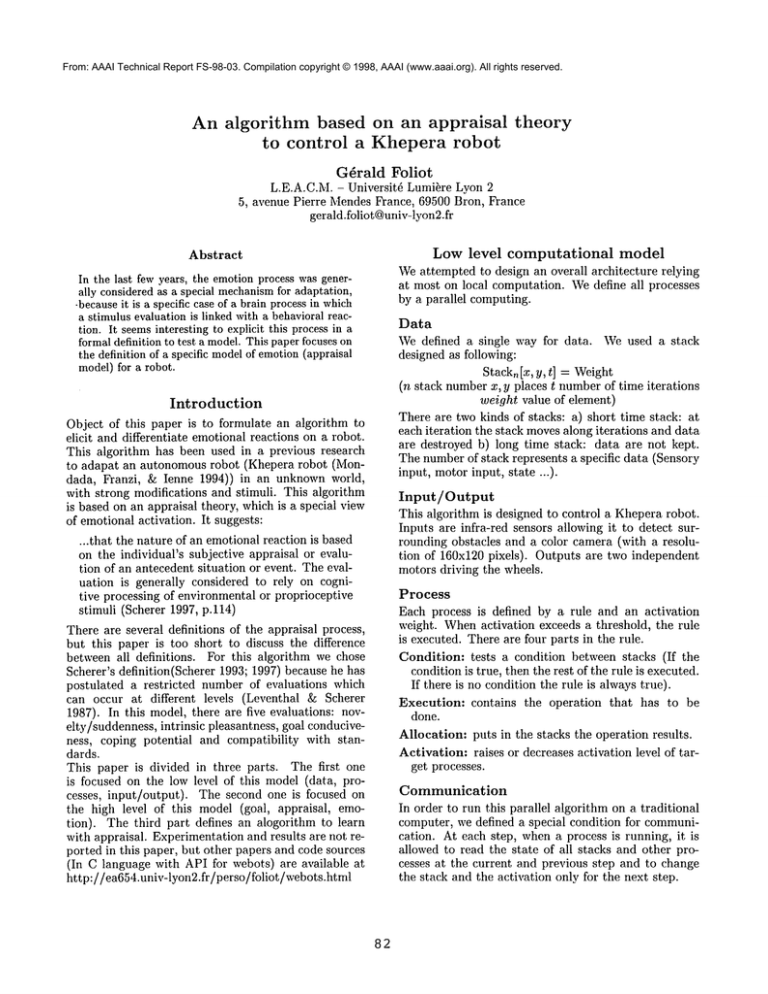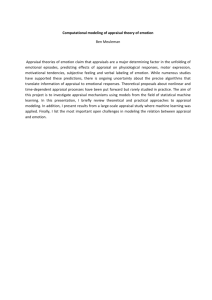
From: AAAI Technical Report FS-98-03. Compilation copyright © 1998, AAAI (www.aaai.org). All rights reserved.
An algorithm based on an appraisal
to control a Khepera robot
theory
G~rald Foliot
L¯E¯A¯C.M. - Universit~ Lumi~re Lyon 2
5, avenue Pierre Mendes France, 69500 Bron, France
gerald.foliot@univ-lyon2.fr
Low level
computational
model
Weattempted to design an overall architecture relying
at most on local computation. Wedefine all processes
by a parallel computing¯
Abstract
In the last few years, the emotionprocess was generally considered as a special mechanism
for adaptation,
-becauseit is a specific case of a brain processin which
a stimulus evaluation is linked with a behavioral reaction. It seemsinteresting to explicit this process in a
formal definition to test a model.This paper focuses on
the definition of a specific modelof emotion(appraisal
model)for a robot.
Data
We defined a single way for data. We used a stack
designed as following:
Stackn[x, y, t] = Weight
(n stack numberx, y places t numberof time iterations
weight value of element)
There are two kinds of stacks: a) short time stack: at
each iteration the stack movesalong iterations and data
are destroyed b) long time stack: data are not kept.
The numberof stack represents a specific data (Sensory
input, motorinput, state ...).
Introduction
Object of this paper is to formulate an algorithm to
elicit and differentiate emotional reactions on a robot.
This algorithm has been used in a previous research
to adapat an autonomous robot (Khepera robot (Mondada, Franzi, & Ienne 1994)) in an unknown world,
with strong modifications and stimuli. This algorithm
is based on an appraisal theory, which is a special view
of emotional activation. It suggests:
Input/Output
This algorithm is designed to control a Khepera robot.
Inputs are infra-red sensors allowing it to detect surrounding obstacles and a color camera (with a resolution of 160x120 pixels). Outputs are two independent
motors driving the wheels.
¯ ..that the nature of an emotionalreaction is based
on the individual’s subjective appraisal or evalution of an antecedent situation or event. The evaluation is generally considered to rely on cognitive processing of environmental or proprioceptive
stimuli (Scherer 1997, p.l14)
There are several definitions of the appraisal process,
but this paper is too short to discuss the difference
between all definitions. For this algorithm we chose
Scherer’s definition(Scherer 1993; 1997) because he has
postulated a restricted number of evaluations which
can occur at different levels (Leventhal & Scherer
1987). In this model, there are five evaluations: novelty/suddenness, intrinsic pleasantness, goal conduciveness, coping potential and compatibility with standards.
This paper is divided in three parts. The first one
is focused on the low level of this model (data, processes, input/output).
The second one is focused on
the high level of this model (goat, appraisal, emotion). The third part defines an alogorithm to learn
with appraisal. Experimentation and results are not reported in this paper, but other papers and code sources
(In C language with API for webots) are available
http://ea654.univ-lyon2.fr/perso/foliot/webots.html
Process
Each process is defined by a rule and an activation
weight¯ Whenactivation exceeds a threshold, the rule
is executed. There are four parts in the rule.
Condition: tests a condition between stacks (If the
condition is true, then the rest of the rule is executed.
If there is no condition the rule is always true).
Execution: contains the operation that has to be
done.
Allocation: puts in the stacks the operation results.
Activation: raises or decreases activation level of target processes.
Communication
In order to run this parallel algorithm on a traditional
computer, we defined a special condition for communication. At each step, when a process is running, it is
allowed to read the state of all stacks and other processes at the current and previous step and to change
the stack and the activation only for the next step.
82
do a low goal on the over direction of novelty stimuli.
Anger: tries to do all goals, excepted the goal causing the anger reaction. Distress: tries to do a random
goal. Sadness: does nothing.
Algorithm of low level
For each step (t,)
Send all sensory data in sensory-stack at tn
For each process
read activation at tn
if(activation > threshold)
read data from stack at t,
test condition
if(condition = true)
execute operation
send data in stack at t+l
send activation a t+l
Read data for motor from motor-stack (tn)
Moveshort time stack
Learning
Weused values returned by appraisal and emotion to
learn. In this model, learning occurs each time the
mean state contains a strong displeasure value. This
produces a new pattern containing the newer stimulus
as a sensory input. The process then waits to observe
which goal is associated to this stimulus and checks
whether this goal allows to comeback to a normal state.
If this normal state is reached within a small amount
of time, the representation is associated to the pattern,
otherwise, the pattern is destroyed.
Hight level
computational
model
Wethink it is necessary to have a single way to represent and interpret all data. A body representation
is a good way to do it, because body-patterns provide
a first organization of data, such as left, right, front,
near, far,... Wetried to represent all data by a value
on the body representation.
Wedefine: a) an input
sensory body representation b) an output motor body
representation c) an internal sensory representation d)
an internal motor representation
Algorithm of learning
If(novelty > 0)
Keep stimulus in memorystack
If(stimulus ==pleasantness)
Destroy stimulus in memorystack
Else
If(stimulus == displeasantness)
Wait and observe the reaction associated
with this stinmlus by emotion
If(reaction decreases displeasantness)
Create an association between stimulus
and motor reaction
If(Waiting is too long)
Stop learning and destroy stimulus
Goal
A goal (such as avoiding obstacles, following a wall,
pushing an object) is defined by an expected value in
the internal body sensory representation and by an expected value in the internal motor representation (such
as movingforward, going left, going right,...)
Acknowledgments
Appraisal
Weused Scherer’s theory, in which there are five appraisals, but we used only four appraisals:
Novelty: tests a difference between the current value
of sensors and the previous value. If there is novelty,
we keep in memory the stimulus which caused the
novelty reaction
Wewould like to thank the Microcomputing and Interface Lab (LAMI- EPFL), represented by Prof. JeanDaniel Nicoud, which supported this research and the
Cyberbotics company represented by Olivier Michel
which provided the Webots simulation software.
Displeasantness: if a pain stimulus is perceived (hit
or warning for example). If there is no pain, then
return pleasantness.
Hindrance:if there is a difference between the input
sensory stack and the expected value
Coping: there are two sorts of coping: a) compares all
possible motor directions with the sensory inputs b)
computes how long a negative emotion appears. The
longer it is, the more important the decreasing of the
coping will be.
Leventhal, H., and Scherer, K. R. 1987. The relationship of emotion and cognition : A fimctional approach
to a semantic controversy. Cogniton and Emotion 1:328.
Mondada, F.; Franzi, E.; and Ienne, P. 1994. Mobile
robot miniaturisation: A tool for investigation in control algorithms. In Yoshikawa, T., and Miyazaki, F.,
eds., Third International Symposium on Experimental Robotics 1993, 501-513. Kyoto, Japan: Springer
Verlag.
Scherer, K. R. 1993. Studying the emotion-antecedent
appraisal process: An expert system approach. Cognition and Emotion 7(3):325-355.
Scherer, K. R. 1997. Profiles of emotion-antecedent
appraisal : Testing theoretical prediction across cultures. Cognition and Emotion 11(2):113-150.
References
Emotions
Each appraisal check activates or inhibites different
emotional processes. Each emotion processes tries to
change the low goal. Wedefined five emotional targets : Joy: focuses on the current goal. Fear: tries to
83






